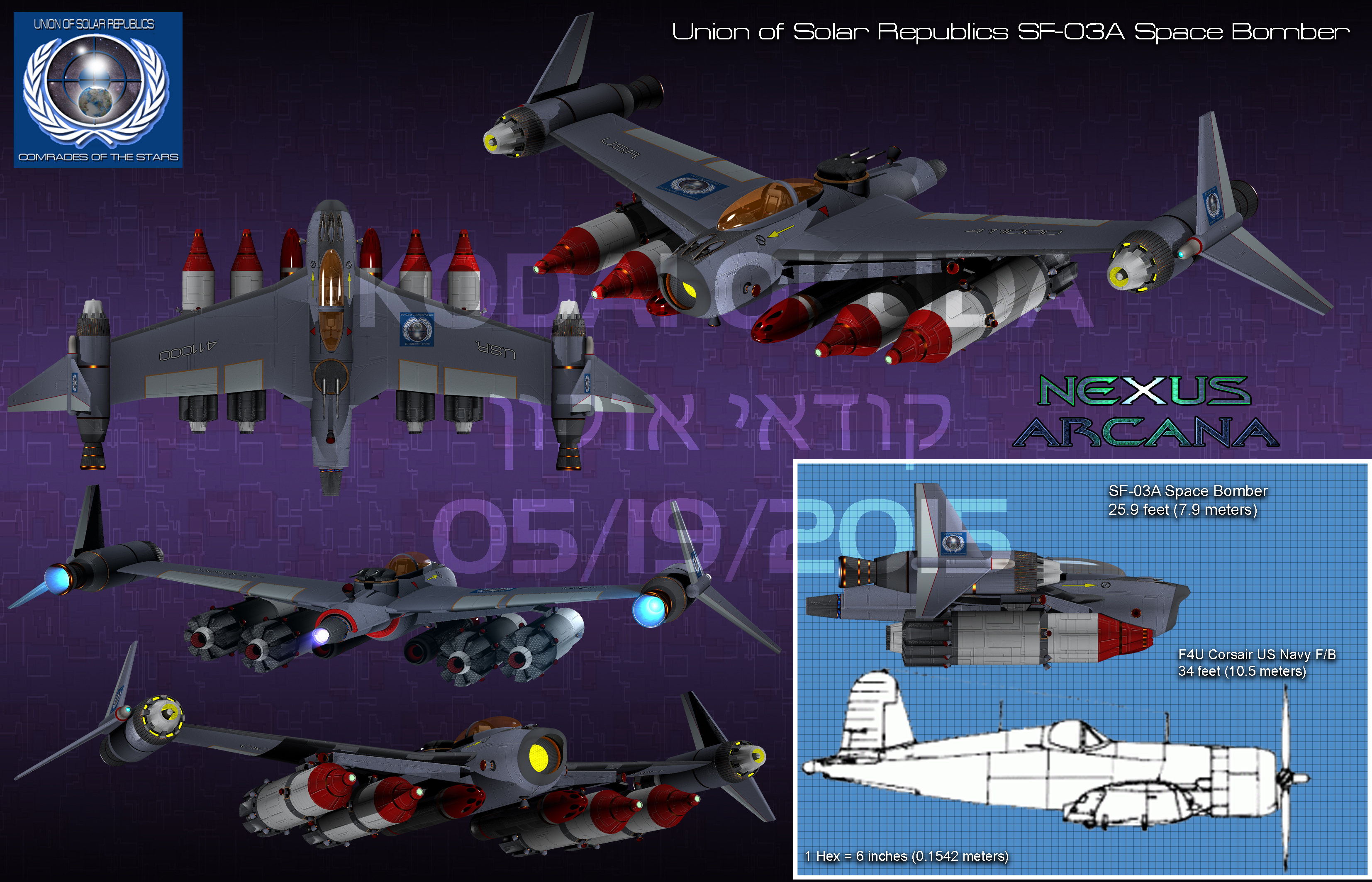SPECIFICATIONS

GOVERNMENT: Union of Solar Republics
TYPE: Medium space-fighter/torpedo bomber
MODEL: Io Factory #18 SF-03A
DATE INTRODUCED: 2176 AD
LENGTH: 26.4 feet
WIDTH: 60 feet
HEIGHT: 13 feet
MATERIAL: Crystal Composite
POWER PLANT: Ganymede Energy GENR-210 nuclear reactor
OUTPUT: 210 megawatts
ARMOR TYPE: Crystal Composite
ARMOR THICKNESS: 2 inches
DISPLACEMENT: 20 tons
CREW: 1Pilot, 1 Gunner
PROPULSION
Combat Speed Engines:
2x Hygiea Factory #9 IE-9 high yield ion engines
SPEED: 22,800 mph each (45,600 mph total)
Main Engine/Cruising Speed Engine:
1x Io Industrial IIPD-10 plasma engine
SPEED: 7,600,000 mph
WEAPONS:
PRIMARY (OFFENSIVE):
3x Lithgear LGRC-20 20-millimeter rail cannon; Effective Range: 460.8 yards; Payload: 3000 rounds on a belt-fed autoloading feed each cannon; ROF: fires a 10, 20, or 30 round burst each cannon with a cyclic rate of up to 1800 rounds per minute.
PRIMARY (ASSAULT):
4x Lithgear LG-CML-5000T heavy space torpedo tube; Missile Type: UN-SRT-5000 short-range 5000-pound computer-guided cruise missile/space torpedo (597.5 kiloton nuclear warhead); Effective Range: 35.1 miles; Payload: 4 torpedoes; ROF: 1, 2, 3 or all 4 at once.
PRIMARY (DEFENSIVE):
1x Lithgear LGPC-10 dual 5-megawatt PHELAC turret; Effective Range: 40 miles; Payload: unlimited with nuclear battery clutch system; ROF: fires one dual blast per ten seconds with a cyclic rate of six dual blasts per minute.
SECONDARY (DEFENSIVE):
2x Io Industrial IISRM-0510 ten-shot short-range 5-pound computer-guided space torpedo with fusion bolt (HEAP, 50 Gigajoules/11.95 tons of explosives) warhead; Effective Range: 10.4 miles; Payload: 80 torpedoes; ROF: 1-10 each missile pod.
ELECTRONICS:
2x Microwave Radio Communications array with a 12,000-mile range.
1x LADAR array with a range of 10,000 miles.
1x Passive EMS Sensor array with a range of 10,000-miles.
2x Multispectral Video/Optical array with a range of 1000 miles.
1x Gravitational/Antigravity Control Unit; Effect: Provides artificial lift, g-force compensation, and enhanced maneuverability.
DEFENSIVE SYSTEMS:
4x Europa Research ER-DF-10 omnidirectional deflector field generators; Range: 10 feet from hull; Power Requirement: 10 megawatts; Output: 500 megajoules of power with a regeneration rate of 50 megajoules every ten seconds.
Description/Overview:
The success of the SF-03 space fighter at the battle of Vesta (when VonStalin’s SF-03 space fighter/torpedo-bombers caused considerable damage to the Zhukovist fleet) impressed the Rebels so much that their leadership ordered their forces at Io to begin developing an improved version of the space fighter that could act as a first-strike fast-attack unit. With this mandate in mind, the research and development group on Io redesigned the SF-03 and upgraded the fighter into a two-seat version they dubbed the SF-03A.
This new space fighter/torpedo-bomber was slightly larger than the original fighter was, but the increased size allowed for considerably more firepower, speed, and protection than the original fighter did.
The engines of the SF-03 were replaced. The two outboard ion engines were upgraded to a pair of Hygiea Factory #9 IE-9 9-megawatt high yield ion engines which raised the maximum speed of the engines from 15,200 mph each drive to 22,800 mph each drive. This provided the fighter with a marginal increase in performance. However, the real improvement to the speed of the fighter was the replacement of the large high yield ion engine with an Io Industrial IIPD-10 10-megawatt plasma drive. This engine provided the SF-03A with the means to be a cosmo-fighter (interplanetary) rather than simply a near-planet space fighter dependent on larger ships to travel between planets in a star-system. This engine provided a speed of 7,600,000 mph, or kiloMach 10, which allowed the USR to launch their fighters prior to their fleet coming anywhere near the firing range of any type of warship of the 1st Interplanetary War era.
The weapons of the SF-03A consisted of the same three forward-firing Lithgear LGRC-20 20-millimeter rail cannons, but it carried four UN-SRT-800A anti-warship short-range space torpedoes instead of only two as on the original SF-03. In addition to these weapons, the SF-03A mounted a pair of Io Industrial IISRM-510 ten-shot short-range missile launchers. These multi-shot missile pods fired the USR-SRM-05 short-range computer-guided missile with HEAP warheads. The payload of each of these pods was 80 missiles giving the cosmo-fighter a total of 160 missiles. This pair of SRM pods gave the SF-03A a fair amount of protection against enemy space fighters and conventional mecha. In addition to the IISRM-510 launchers, a Lithgear LGP-10 PHELAC dual 5-megawatt turret was mounted on top of the fighter to the rear of the cockpit. The gunner/co-pilot, whose helmet acted as a targeting system for the cannon, manned the turret. Thus, wherever the pilot turned his head the turret followed within the arcs of the cannon. This cannon could fire up to twelve dual blasts per minute which allowed the gunner/co-pilot to shoot down pursuing mecha tailing the SF-03A should the need arise during combat.
The defense system of the original SF-03 was simply its energy resistant armor. This was not so in the SF-03A, which used a combination of traditional crystal composite armor plating, and four Europa Research ER-DF-10 10-megawatt deflector field generators. These deflector fields were used only to deflect individual attacks from other space fighters and mecha weaponry. These shields could protect the space fighter only on the port and starboard sides. Each side had two generators that were “layered” over one another on their respective sides giving double the listed gigajoule output.
The SF-03A was a very successful design and proved itself during the USR invasion of the Mars sphere in 2176-77 AD. This cosmo-fighter was produced by the USR from 2176 into the early 2190s. The exact numbers of these machines is unknown as various colonial governments during the late 2180s and early 2190s produced it.


